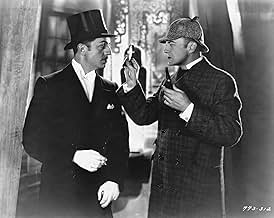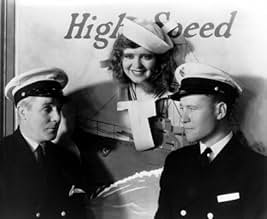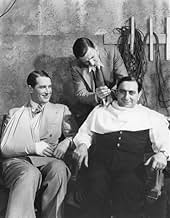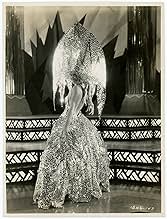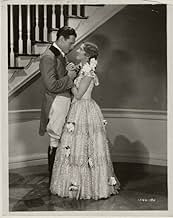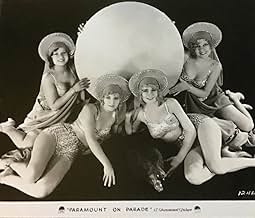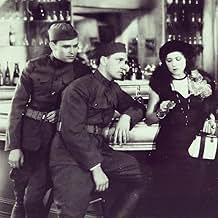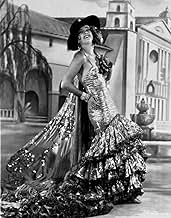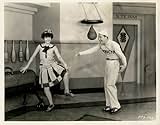Ajouter une intrigue dans votre langueA musical revue that has Paramount stars and contract-players doing unrelated short sketches and elaborately staged song-and-dance numbers like a duet on a giant cuckoo clock and Clara Bow s... Tout lireA musical revue that has Paramount stars and contract-players doing unrelated short sketches and elaborately staged song-and-dance numbers like a duet on a giant cuckoo clock and Clara Bow singing aboard a navy vessel.A musical revue that has Paramount stars and contract-players doing unrelated short sketches and elaborately staged song-and-dance numbers like a duet on a giant cuckoo clock and Clara Bow singing aboard a navy vessel.
- Réalisation
- Scénario
- Casting principal
- Récompenses
- 3 victoires au total
Charles 'Buddy' Rogers
- Buddy Rogers - Episode 'Love Time'
- (as Buddy Rogers)
Avis à la une
I've just watched the current restoration and can add some information to the 2002 review.
The footage of the opening "Showgirls on Parade" sequence is missing but the sound survives.
The sound disc for "Isadore the Toreador" has been located (only a few days ago) and will be put into the next restoration with the surviving Technicolor footage..
Nino Martini's number is now complete, and in Technicolor.
The "Dream Girl" Technicolor footage survives but the sound is missing.
The "Gallows Scene" is missing most of the sound except for Dennis King's song.
The footage of the opening "Showgirls on Parade" sequence is missing but the sound survives.
The sound disc for "Isadore the Toreador" has been located (only a few days ago) and will be put into the next restoration with the surviving Technicolor footage..
Nino Martini's number is now complete, and in Technicolor.
The "Dream Girl" Technicolor footage survives but the sound is missing.
The "Gallows Scene" is missing most of the sound except for Dennis King's song.
"Paramount on Parade" (Paramount, 1930), with various directorial credit including Ernst Lubitsch, A. Edward Sutherland and Victor Schertzinger, among others, became Paramount's attempt in an all-star movie revue, following the earlier attempts of MGM's "The Hollywood Revue of 1929" and "The Show of Shows" for Warner Brothers, and while many claim this to be the best of the revues, I find it to be a disappointment mainly because the print that's been circulating on television over the last couple of decades, and later cable television, not being the entire movie. Even though I wasn't around when the 102 minute presentation of "Paramount on Parade" was released in theaters, the cuts are quite obvious, especially when French entertainer Maurice Chevalier gives Italian singer Nino Martini a special introduction, and later on in the revue, director Edmund Goulding preparing his cast of actors who are to appear in a Civil War setting musical skit, "Let Us Drink to the Girl of My Dreams," with Gary Cooper, Fay Wray, among others, which never comes. At present, "Paramount on Parade" runs 78 minutes, minus Technicolor segments. Whether the missing scenes are lost forever, or a complete copy is displayed somewhere in a dark vault gathering dust, is anyone's guess. However, at present, it appears that possible restoration of this movie is unlikely to occur.
The "Paramount on Parade" program is as follows, with the deleted scenes preceded with asterisks (*): * SHOWGIRLS ON PARADE (with Virginia Bruce); * PARAMOUNT ON PARADE (chorus); "We're the Masters of Ceremonies" (sung by Jack Oakie, Richard "Skeets" Gallagher and Leon Errol); "Any Time's the Time to Fall in Love" (sung by Buddy Rogers and Lillian Roth); MURDER WILL OUT (a comedy sketch with William Powell as Philo Vance; Clive Brook as Sherlock Holmes; Warner Oland as Fu Manchu, with Eugene Palette and Jack Oakie; THE ORIGIN OF THE APACHE (with Maurice Chevalier and Evelyn Brent); IN A HOSPITAL (comedy sketch with Leon Errol, Jean Arthur, Phillips Holmes and David Newell); "I'm in Training for You" (sung by Zelma O'Neal and Jack Oakie); * THE TOREADOR (with Harry Green singing "I'm Isador the Toreador" from Bizet's CARMEN, with Kay Francis); "My Marine" (sung by Ruth Chatterton, with Fredric March, Stanley Smith and Stuart Erwin as Marines); "All I Want is Just One Girl" (sung by Chevalier); MITZI GREEN HERSELF (with Mitzi Green reprising "All I Want Is Just One Girl" and doing imitations of Chevalier and Charles Mack of the comedy team of Moran and Mack, The Two Black Crows); "What Did Cleopatra Say?" (sung by Helen Kane); *THE GALLOWS SONG (sung by Dennis King); "Dancing to Save My Sole" (sung and danced by Nancy Carroll and Al Norman, the eccentric rubber-legs dancer); * DREAM GIRL, "Let Us Drink to the Girl of My Dreams" (with Richard Arlen, Jean Arthur, Gary Cooper, Mary Brian, Virginia Bruce, Fay Wray, and others); "I'm True to the Navy Now" (sung by Clara Bow and sailors); FOLLOWING YOUR IMPULSE: (Introduced by George Bancroft in a comedy sketch about social manners showing how people at a function normally act, then presenting them on how they really feel. Kay Francis partakes in this skit); and the finale, "Sweeping the Clouds Away" (sung by Maurice Chevalier).
As with the previous Hollywood revues, portions of the film succeed musically and comically, while others don't. Highlights include Zelma O'Neal's energetic singing and opposite Jack Oakie in the gymnasium; Nancy Carroll's dance number on top of a giant shoe; Maurice Chevalier's finale; and of course Clara Bow, who brings this revue to life as the sole female vocalist amongst a group of sailors. Her singing voice does record well, but her career in talkies came to an end by 1933. The lesser moments are the comedy skits, including Leon Errol in the hospital bed with his good-for-nothing sons ignoring his requests and telling their dad to "Shut up"; Mitzi Green's dated impersonations of Moran and Mack; and the singing of "My Marine" by Ruth Chatterton, who performs better as dramatic actress than as a singer, making this eight minute segment seems longer than it is. Helen Kane's "Boop, Boopa Doop" number in the classroom starts off well, but grows tiresome only after a few minutes.
American Movie Classics formerly presented the edited version of "Paramount on Parade" back in 1988-89, and since then, is hardly shown at all these days. However, if this revue should ever resurrect again, whether on video or on Turner Classic Movies, let's hope for a restored complete version. Maybe the 102 minute edition might not make much of a difference entertainment wise, but it certainly will be a rare treat indeed. As it now stands ... (***)
The "Paramount on Parade" program is as follows, with the deleted scenes preceded with asterisks (*): * SHOWGIRLS ON PARADE (with Virginia Bruce); * PARAMOUNT ON PARADE (chorus); "We're the Masters of Ceremonies" (sung by Jack Oakie, Richard "Skeets" Gallagher and Leon Errol); "Any Time's the Time to Fall in Love" (sung by Buddy Rogers and Lillian Roth); MURDER WILL OUT (a comedy sketch with William Powell as Philo Vance; Clive Brook as Sherlock Holmes; Warner Oland as Fu Manchu, with Eugene Palette and Jack Oakie; THE ORIGIN OF THE APACHE (with Maurice Chevalier and Evelyn Brent); IN A HOSPITAL (comedy sketch with Leon Errol, Jean Arthur, Phillips Holmes and David Newell); "I'm in Training for You" (sung by Zelma O'Neal and Jack Oakie); * THE TOREADOR (with Harry Green singing "I'm Isador the Toreador" from Bizet's CARMEN, with Kay Francis); "My Marine" (sung by Ruth Chatterton, with Fredric March, Stanley Smith and Stuart Erwin as Marines); "All I Want is Just One Girl" (sung by Chevalier); MITZI GREEN HERSELF (with Mitzi Green reprising "All I Want Is Just One Girl" and doing imitations of Chevalier and Charles Mack of the comedy team of Moran and Mack, The Two Black Crows); "What Did Cleopatra Say?" (sung by Helen Kane); *THE GALLOWS SONG (sung by Dennis King); "Dancing to Save My Sole" (sung and danced by Nancy Carroll and Al Norman, the eccentric rubber-legs dancer); * DREAM GIRL, "Let Us Drink to the Girl of My Dreams" (with Richard Arlen, Jean Arthur, Gary Cooper, Mary Brian, Virginia Bruce, Fay Wray, and others); "I'm True to the Navy Now" (sung by Clara Bow and sailors); FOLLOWING YOUR IMPULSE: (Introduced by George Bancroft in a comedy sketch about social manners showing how people at a function normally act, then presenting them on how they really feel. Kay Francis partakes in this skit); and the finale, "Sweeping the Clouds Away" (sung by Maurice Chevalier).
As with the previous Hollywood revues, portions of the film succeed musically and comically, while others don't. Highlights include Zelma O'Neal's energetic singing and opposite Jack Oakie in the gymnasium; Nancy Carroll's dance number on top of a giant shoe; Maurice Chevalier's finale; and of course Clara Bow, who brings this revue to life as the sole female vocalist amongst a group of sailors. Her singing voice does record well, but her career in talkies came to an end by 1933. The lesser moments are the comedy skits, including Leon Errol in the hospital bed with his good-for-nothing sons ignoring his requests and telling their dad to "Shut up"; Mitzi Green's dated impersonations of Moran and Mack; and the singing of "My Marine" by Ruth Chatterton, who performs better as dramatic actress than as a singer, making this eight minute segment seems longer than it is. Helen Kane's "Boop, Boopa Doop" number in the classroom starts off well, but grows tiresome only after a few minutes.
American Movie Classics formerly presented the edited version of "Paramount on Parade" back in 1988-89, and since then, is hardly shown at all these days. However, if this revue should ever resurrect again, whether on video or on Turner Classic Movies, let's hope for a restored complete version. Maybe the 102 minute edition might not make much of a difference entertainment wise, but it certainly will be a rare treat indeed. As it now stands ... (***)
A couple of years into the Talkie revolution, several studios put on feature-length revues to promote their brand, of which Paramount's effort seems to have been better than most, even though it has not worn particularly well since. (Also the print I watched was notably fuzzy and dim.)
Deservedly, it gives generous exposure to Maurice Chevalier, who had just rescued the studio's fortunes with his Ruritanian romance 'The Love Parade', just as the Wall Street crash was threatening to ruin Hollywood. In particular, his energetic closing act, 'Sweeping the Clouds Away', accompanied by an endless line of leggy beauties, was clearly meant as a cheer-up call for the Depression-hit masses.
As for the other performers, I can only say that they remind us of the transience of fame (at a range of nearly a century). Not one in ten of these names mean anything to us today. Jack Oakie seems to occupy second place, and although I have often enjoyed his work, I think he was personality rather than artistry. Interesting to catch a glimpse of the young Frederick March. Otherwise, Gary Cooper, Clara Bow and Fay Wray more-or-less complete the roll of memorable stars.
Deservedly, it gives generous exposure to Maurice Chevalier, who had just rescued the studio's fortunes with his Ruritanian romance 'The Love Parade', just as the Wall Street crash was threatening to ruin Hollywood. In particular, his energetic closing act, 'Sweeping the Clouds Away', accompanied by an endless line of leggy beauties, was clearly meant as a cheer-up call for the Depression-hit masses.
As for the other performers, I can only say that they remind us of the transience of fame (at a range of nearly a century). Not one in ten of these names mean anything to us today. Jack Oakie seems to occupy second place, and although I have often enjoyed his work, I think he was personality rather than artistry. Interesting to catch a glimpse of the young Frederick March. Otherwise, Gary Cooper, Clara Bow and Fay Wray more-or-less complete the roll of memorable stars.
Of the early talkie-era all-star revues, this one is by far the most "fun." The song sequences are nicely done; in particular, the "Dancing to Save Your Sole" segment with Nancy Carroll. Maurice Chevalier does very well in his three segments, one comedy segment, one comedy musical segment (bearing the noticable stamp of Lubitsch), and the entertaining finale. The comic segments are a bit hit or miss, but the Philo Vance/Sherlock Holmes/Fu Manchu skit near the start is a must-see. I saw this in an old TV print; the color sequences mostly exist, but have yet to be restored, and the copy of most prints that circulate is servicable, but not spectacular. Find the best print you can.
This was the type of variety show which most of the studios made which was popular in the early days of sound. In this case, the film consists of various short sketches, including musical numbers, comedy bits, and even a dramatic scene. The stars include Maurice Chevalier, Clara Bow, Ruth Chatterton, Fredric March, Gary Cooper, George Bancroft, Jack Oakie, Skeets Gallagher, Buddy Rogers, Kay Francis, Jean Arthur, Mary Brian, Fay Wray, Evelyn Brent, Leon Errol, William Powell, Warner Oland, Clive Brook, Eugene Pallette, Lillian Roth, Stu Erwin, Helen Kane, Nancy Carroll, and Mitzi Green.
Paramount also enlisted a posse of directors, including Edmund Goulding, Dorothy Arzner, Ernst Lubitsch, Rowland V. Lee, Victor Scherzinger, and more. Several of the film's segments, including a few in early Technicolor, were missing from the copy that I watched. In fact, the segment featuring Cooper, Brian, Arthur and Wray only consisted of the intro. My favorite segments include the very silly detective bit with Clive Brook as Sherlock Holmes, Powell as Philo Vance, and Oland as Fu Manchu; Chevalier and Brent in a lover's quarrel; Ruth Chatterton as a sad French prostitute who sings a song to American G. I.s (including March) about to return home from WWI; and a comedy piece with Chevalier as a gendarme patrolling a park popular with lovers. Most of the song and dance numbers were largely forgettable, though. Still, it was nice to see for a different look at the various stars.
Paramount also enlisted a posse of directors, including Edmund Goulding, Dorothy Arzner, Ernst Lubitsch, Rowland V. Lee, Victor Scherzinger, and more. Several of the film's segments, including a few in early Technicolor, were missing from the copy that I watched. In fact, the segment featuring Cooper, Brian, Arthur and Wray only consisted of the intro. My favorite segments include the very silly detective bit with Clive Brook as Sherlock Holmes, Powell as Philo Vance, and Oland as Fu Manchu; Chevalier and Brent in a lover's quarrel; Ruth Chatterton as a sad French prostitute who sings a song to American G. I.s (including March) about to return home from WWI; and a comedy piece with Chevalier as a gendarme patrolling a park popular with lovers. Most of the song and dance numbers were largely forgettable, though. Still, it was nice to see for a different look at the various stars.
Le saviez-vous
- AnecdotesOf the original 20 individual sequences, seven of them were filmed in 2-strip Technicolor: the opening sequence: 'Showgirls on Parade', Nino Martini's 'Come Back to Sorrento,' Harry Green's 'Isadore the Toreador' with Kay Francis, Dennis King's 'Nitchavo,' 'Girl of My Dreams', with Richard Arlen, Jean Arthur, Mary Brian, Virginia Bruce, Gary Cooper, James Hall, Phillips Holmes, David Newell, Joan Peers, and Fay Wray, of which only the B&W introduction survives, and the 'Rainbow Revels' finale featuring Maurice Chevalier singing 'Sweeping the Clouds Away', which also survives in B&W. The total Technicolor footage was 2517 feet (768 m), or about 28 minutes.
- GaffesThe re-release opening credits credit producer Jesse L. Lasky as "Jessie" L. Lasky.
- Citations
Jack Oakie: It's a mystery play written especially for me!
- Versions alternativesVersion for distribution of the original film in Romania, titled Parada Paramount (1930) included additional sketches by Romanian actors Ion Ian-Covescu and Pola Iliescu
- ConnexionsAlternate-language version of Parada Paramount (1930)
- Bandes originalesAll I Want Is Just One Girl
Music by Richard A. Whiting
Lyrics by Leo Robin
Sung by Maurice Chevalier
Sung also by Mitzi Green
Meilleurs choix
Connectez-vous pour évaluer et suivre la liste de favoris afin de recevoir des recommandations personnalisées
- How long is Paramount on Parade?Alimenté par Alexa
Détails
- Date de sortie
- Pays d’origine
- Langues
- Aussi connu sous le nom de
- Paramount Şeref Geçidi
- Lieux de tournage
- Société de production
- Voir plus de crédits d'entreprise sur IMDbPro
- Durée1 heure 42 minutes
- Couleur
- Rapport de forme
- 1.20 : 1
Contribuer à cette page
Suggérer une modification ou ajouter du contenu manquant

Lacune principale
By what name was Paramount on Parade (1930) officially released in India in English?
Répondre
